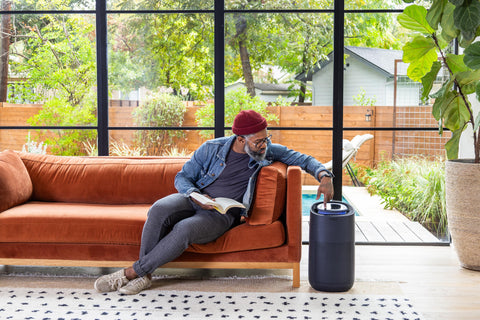5 Common Myths About Air Purifiers
Maybe you’ve thought of investing in an air purifier but aren’t quite sure you believe in the technology. Is it worth the cost? In this blog, we’re tackling some of the most common myths and misconceptions about air purification technology so that you can make an informed decision.
5 Myths About Air Purifiers… Debunked!
Don’t let this misinformation fool you. Let’s separate fact from fiction.
1. Air Purifiers Make You Sick
This one might be the biggest myth about air purifiers, and also the most dangerous. Fact: Air purifiers do not make you sick.

Let’s start with the misconception that air purifiers give off scary levels of radiation. Here’s the truth: Several things you use every single day — like your cellphone, Wi-Fi, and microwave — give off electric and magnetic fields (EMF), also called radiation. That includes your air purifier. However, the levels of EMF are so low that they cannot cause damage.
You may have also heard that air purification systems can create ozone, and this can be true. However, all you need to do is opt for a mechanical purifier over an electric one. A mechanical air purifier will use physical filters to clean the air. For instance, Sans uses a medical-grade HEPA 13 filter.
Finally, some people think air purifiers make you sick because of all the nasty germs they catch. This is only a concern if you use a purifier with a washable filter. This means you need to attempt to manually clean it yourself, which is difficult to do and exposes you to that bacteria. Instead, go for an air purifier with a replaceable filter, which is what Sans uses.
2. Your HVAC System is Already Filtering Your Air
You have to change your air conditioner’s filter every so often, so it must be cleaning the air, right? Well, sort of… but not really. These filters aren’t designed to filter the air. While they might look dirty when you remove them, at best, they’re only targeting pollutants that are very large in size.
On the other hand, Sans’ medical-grade filtration captures 99.97% of particles that are as tiny as 0.3 microns in diameter. For reference, on the smaller side, human hair can be 50 microns thick! In other words, not much can get past our air purifier.

3. If Your House is Clean, You Don’t Need an Air Purifier
Even the world’s biggest neat freak will benefit from an air purification system. While you might clean the floors and countertops daily, you can’t really clean the air. And that’s what an air purifier is for!
Dust, fur, hair, and animal dander are constantly floating around — and these are only the particles you can actually see. What about airborne pathogens that can make you sick?
Psst! Learn about how to keep your home dust-free.
It’s still a good idea to clean your home regularly because it’s going to allow your air purifier to better do its job. This will especially help if you have animals that shed, as their fur and dander can easily travel through your home.
4. Cracking a Window or Keeping Plants Indoors is Enough to Purify the Air
You may have heard that plants help clean the air, and under the right circumstances, this can be true! However, even if you filled your home with plants, they wouldn’t be able to keep up with the heavy lifting of purifying your breathing air.
Opening a window or door is a similar story. Yes, you might let some “fresh” air in, but how fresh is it, really? The air outside is polluted too. And this will be even worse if you live in a high-traffic area, near wildfires, or in an industrial town. In this case, it’s better to leave the windows closed!
The best way to take control of your indoor air quality is with an air purifier, plain and simple.
5. All Air Purifiers Work Pretty Much the Same
This is false, and it’s important to do your due diligence before making a decision.
You know now that replaceable filters are far better than washable ones, so this is one important distinction to make.
You also want to go with an air purifier that has multiple layers of defense. For instance, Sans uses a pre-filter, medical-grade HEPA 13 filter, activated carbon filter, and UV-C. This is what it takes to target particles both big and small.

Additionally, not all purifiers offer real-time insight into the quality of your air. Sans monitors the quality and displays it on the screen so that you always know what you’re working with. And when it’s time to replace the filter, it’ll let you know so that it can continue running optimally. In fact, it’ll run all on its own, as needed.
In a nutshell, you need air purification technology that’s going to do all the heavy lifting for you. This is how you can keep yourself and your family safe and healthy.
Wrapping Up and FAQs
Now that you know the truth behind air purifiers and what to look for, are you ready to make a move? Shop our full-size purifier, the Sans mini, and replacement filters today.
Frequently Asked Questions
Is there a downside to air purifiers?
Potential downsides will only arise if you select an air purifier that doesn’t have more advanced and current technology, like a medical-grade HEPA 13 filter.
However, with the proper inner workings, air purifiers are proven to be effective in cleaning the air you breathe.
Do air purifiers actually make a difference?
Yes! Sans’ medical-grade filtration captures 99.97% of particles that are as tiny as 0.3 microns in diameter. This means it can even target airborne viruses and bacteria that can make you sick.
What should you avoid when buying an air purifier?
Avoid purification systems that utilize washable filters, one layer of filtration, and anything less than a medical-grade HEPA 13 filter. These purifiers won’t be able to do nearly as good of a job at cleaning your air.